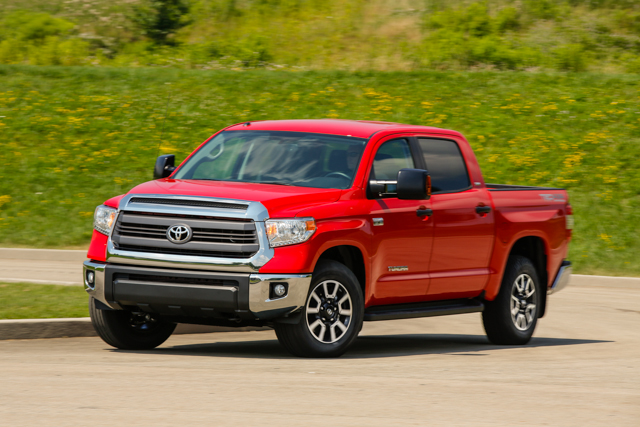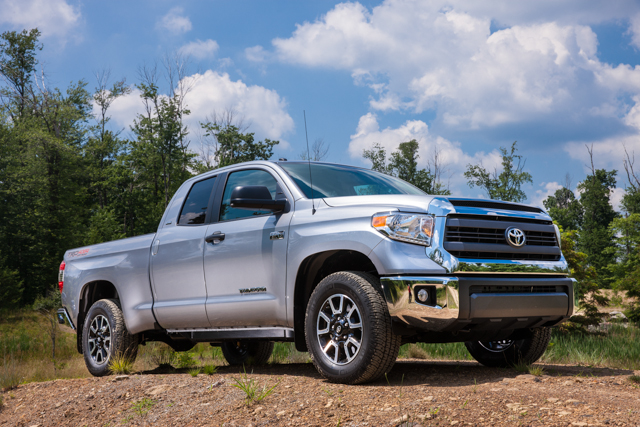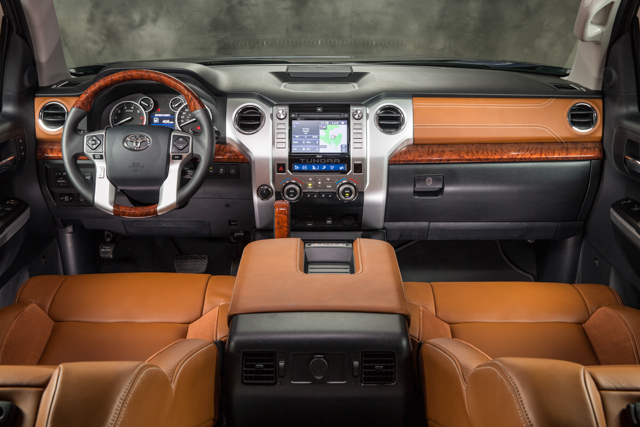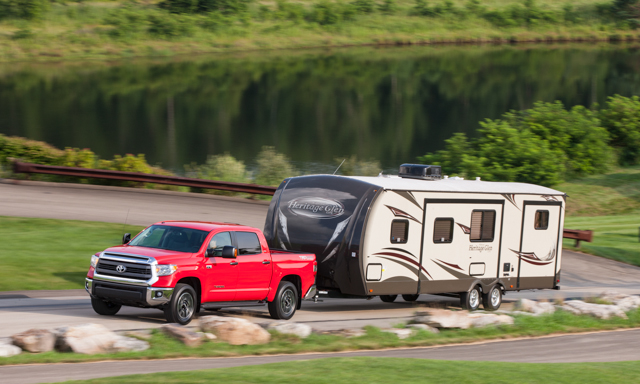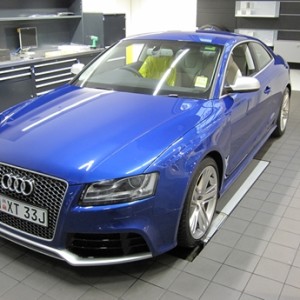How do you find a place in a closed club? That’s a question Toyota has been trying to answer with the Tundra for years. The full-size pickup market in the U.S. might as well be a members-only club; for years it was neatly locked up by Ford, Chevy/GMC and Dodge, and that was that. The Big Three squeezed International and Jeep out in the 1970s, and nobody even thought to try to crack the market until 1999, when Toyota brought out a full-size truck of its own. Nissan followed suit five years later.
So how did the newcomers fit? The Nissan Titan has found its niche among the Mountain Dew-chugging extreme sports types, and the Tundra … remains somewhat faceless. Though it’s generally been able to match the competition in terms of toughness, there’s always been something missing. It seems the Tundra just can’t get any respect, in spite of matching the Big Three’s offerings in terms of capability and having more American content than many American-badged cars.
With a major refreshing for 2014, Toyota’s seeking approval via a time-honored manly-man route: It’s bulking up. In terms of both aesthetics and function, the new Tundra’s gotten bigger and tougher. Where the Chevy Silverado and Ram 1500 have gotten leaner looks for 2014, the Tundra’s bigger and blockier. The rounded aspects of the styling have been toned down in favor of a more chiseled look. The Tundra has a taller hood, squarer shoulders and more distinct wheel flares. At the rear, the tailgate’s got an embossed TUNDRA stamp and smooth contours that emphasize the truck’s width. Cost-saving, three-piece modular bumpers use thicker steel and have three-piece construction to facilitate inexpensive repairs.
To meet a wide range of drivers’ needs, the Tundra’s available with three cab sizes, two bed lengths and five trim levels. Each trim level has a unique grille, providing a range of styling choices as well as capability. The Tundra can be outfitted as a luxury truck for the city, as in the Platinum model, or for the ranch, in the new-for-2014 1794 Edition.
Subtle changes to functionality provide surprise-and-delight benefits. Toyota’s aerodynamic “vortex generators” are used on the mirrors and taillights to minimize micro-vacuum effects along the sides of the Tundra, resulting in improved straight-line stability on the freeway. The 4 & 7-Pin trailer-towing connector has been moved to inside the bumper, where it’s protected from dirt and illuminated by the license plate light.
The previous Tundra’s interior was criticized for looking cheap. In response, materials and craftsmanship have been improved dramatically, and it looks good, especially in the 1794 Edition, where warm earth tones are combined with wood trim and high-grade leather. The look is not as Texas-kitschy as in the Ford King Ranch, but neither does it imitate luxury cars as some other premium trucks do. The Tundra 1794 Edition’s cabin strikes a nice balance between rugged and plush for a distinctly truck-ish version of premium comfort.
The new dash is easier to read, and features a 3.1-inch TFT information screen in the center. A backup camera and display now are standard, and there’s a handy storage cubby in the top of the center console. In the Platinum and 1794 Edition, the seat leather’s borrowed from Lexus. Toyota’s Entune infotainment system also is available, and will feature a new range of apps starting in August.
So the new Tundra looks the part and is comfortable inside. That’s only good for a partial grade when it comes to trucks, though. In the end, it’s the numbers that count. The burly Tundra hasn’t neglected that side of the equation though. Toyota continues with a three-engine strategy in the Tundra, offering a choice of 4.0 liter and 4.6 liter V-6 engines and the massive 5.7 liter V-8. The V-8 features a new six-speed automatic transmission, and Tundras thus equipped will haul more than 1 ton in the bed, with a 10,000-pound towing capacity. All three engines are amazingly quiet on the road and well suited to truck-like work.
To toughen this truck up, Toyota loaned prototypes to farm and ranch owners and asked them to replace their ¾- and 1-ton trucks. Preparing the Tundra for this kind of abuse and over-use in the field resulted in a wide range of durability improvements, including a military-style wrap on the leaf springs that prevents the axle from coming loose should the spring break, a steep 25-degree approach angle, and improved steering stability. When it comes time to work, the Tundra rolls up its sleeves and dives right in. When equipped with a trailer brake controller, the Tundra’s happy to haul an 8,000-pound trailer, and the truck is stable and never overworked, even with a load that size out back.
The revised suspension improves torsional stability, but it’s still pretty softly sprung. This results in some head-toss at speed. The Tundra’s ride is much closer to the “luxury” end of the spectrum rather than “sporty,” and rapid steering transitions will result in a knock-kneed, wobbly response. Stability control keeps it in line. In the Tundra’s favor, smooth driving is rewarded with a smooth ride. On the road, it’s the polar opposite of the brutal Nissan Titan.
Opt for the off-road package, and Bilstein shocks are added to the mix, as well as an exclusive Michelin LTX AT2 tire designed just for the Tundra, with an off-road sidewall tread that improves grip and performance in the mud. The Tundra will lumber through shockingly hostile terrain in low range, with tires finding traction on rocks, logs and mud as though the truck has been taking lessons from the off-roaders in Toyota’s stable. A limited-slip differential is available.
The Tundra is a big, tall truck, and it has no intention of letting you forget that. Even two-wheel drive models are chest-high to a 6-foot driver. Though it’s got surprisingly docile road manners and quiet interior, it’s not fair to say that the Tundra drives like a Camry, because there’s nothing carlike about it. This is a big and powerful — yet quiet — truck. 2014 Tundra prices have been reduced slightly, starting at $25,920 for a two-wheel drive SR regular cab. The range is topped by the $47,320 Platinum and 1794 Edition trucks, with four-wheel drive and the 5.7 liter V-8.


